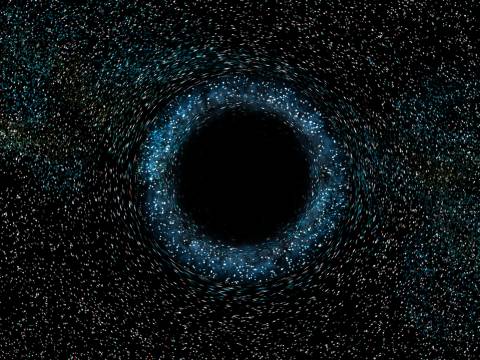Scientists and science fiction writers alike ask this question, but not everyone can easily test it in the real world.
In an attempt to answer this question visually, Alessandro Roussel, a French theoretical physicist who studied at Cambridge University, released a pair of videos on his science channel ScienceClic.
A number of mathematicians and theoretical physicists have proposed ideas about what might happen if someone or something tried to enter a black hole. A recent article noted that they might even represent the entrance door to an interstellar wormhole that could transcend space and time.
Such ideas are popular in science fiction, where the pervasive gravity of black holes is often overcome. However, most scientists believe that the forces of a real black hole would be too great to survive, and the intense effects of its insane gravity would probably make death both beautiful and terrifying.
At the beginning of the first clip, Roussel draws attention to the massive black hole at the center of the Milky Way galaxy. Called Sagittarius, this light-sucking space hole sits idly, waiting for the illustrator’s theoretical spaceship to approach.
Here, Roussel forces his theoretical space traveler out of the ship and begins his descent into the black hole, which he notes “will last about an hour” and “will be fatal for us.” The video then breaks down into two main parts.
The first, titled “PHASE 1: BEFORE FALL,” describes the problems our intrepid space traveler will face even before entering the black hole because of the enormous mass the black hole contains. It also takes into account radiation, which, as Roussel notes, will “blind” our space traveler almost immediately, if not simply burn him alive.
After 57 minutes of a theoretical hour-long journey, with proper protection from heat and radiation, the hypothetical space traveler has reached the threshold of the edges of the black hole, or event horizon. This is where the second part of the video, PHASE 2: THE TRANSITION OF THE HORIZON, begins.
At this point, the video notes, “the passengers remaining in the spaceship see our image fade and gradually slow down until it freezes at the horizon. The reasons for this are extremely interesting, and as a result, the intrepid traveler crosses the “photon barrier” and finds himself so close to the actual event horizon. “It will be impossible for us to go back after this point,” the video says.
What the astronaut sees and feels in this moment is described in great detail and deserves close attention. But the most incredible moment is what happens when the traveler finally approaches the center of the black hole itself. No spoilers, but the term “spaghettification” is not exactly scientific, and not in a good way.
As Rousell notes, what happens next, no one knows. His video states that “modern physics cannot describe what happens so close to the center of a black hole” before moving on to some theories, but even then no concrete answer is given. Nevertheless, the visual effects are impressive, and the ideas presented give a good, easy-to-understand idea of what most scientists think would happen if someone actually tried to enter a black hole.
Just for fun, the same YouTube channel provided a quick video animation of the whole thing without any narration. It’s a great watch all on its own, and lasts just two minutes. So eat that popcorn fast. Or some spaghetti (you’ll get that joke after watching the video).














